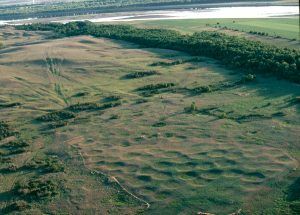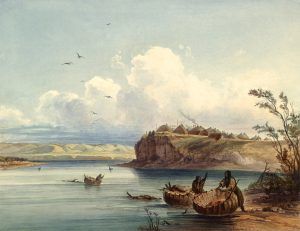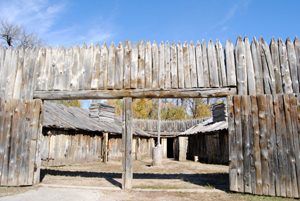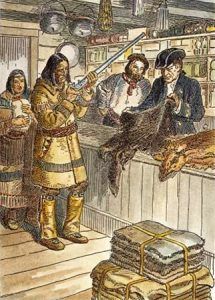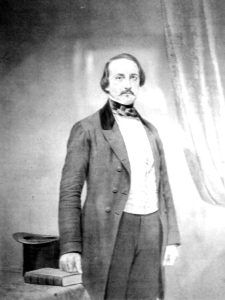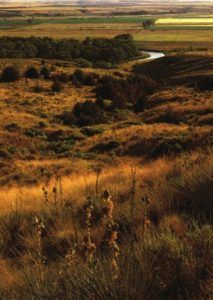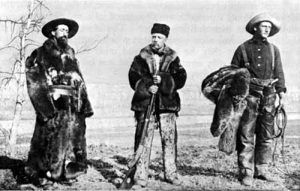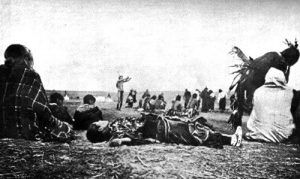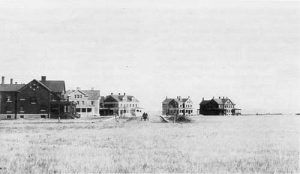Significant events in North Dakota’s history
1600s – The Cheyenne, living in earth lodges, occupied the Cheyenne River valley; the Hidatsa moved west from Devils Lake to the Missouri River; the Sioux moved onto the plains from the woodlands of Minnesota.
1610 – Henry Hudson claimed the Hudson Bay watershed, which included much of eastern North Dakota for England.
1682 – La Salle claimed the entire Mississippi River drainage, including the Missouri River drainage in North Dakota, for France.
1713 – England receives the northern part of North Dakota from France.
1738 – Pierre Gaultier de la Vérendrye, a French explorer, visited Mandan villages near the Missouri River. This is the first known Euro-American expedition into what is now North Dakota.
1742 – The sons of La Verendrye returned to the Missouri River as part of an expedition in search of a western sea. Subsequent explorers to visit this region included Jonathan Carver (1768) and David Thompson (1797), among others.
1762 – Spain received from France land claimed by LaSalle.
1763 – Treaty of Paris granted England part of the state drained by the Mouse and the Red Rivers.
1781 – The first known business enterprise, a fur trading post, was briefly established near the Souris River but was soon abandoned due to pressure from unfriendly Indians.
1792 – Jacques D’Englise (Santiago Leglise) opened trade between Mandan villages and Spanish interests from St. Louis.
1794 – Rene Jusseaume builds a fur-trading post near present-day Washburn along the Knife River.
1796 – John Evans from St. Louis ascended the Missouri River to the Mandan villages near the Knife River.
1797 – Alexander Henry Jr. starts a fur-trading post at Park River and moves it to Pembina in 1801. The post attracts the first white settlement in North Dakota.
David Thompson, an English explorer, mapped the northern part of the state.
1800 – Alexander Henry Jr. established a fur post at Park River. Henry moved his establishment to Pembina in 1801, and it became the nucleus for the first white settlement in what is now North Dakota.
By this date, fur traders from Canada were frequent visitors to this region. A trade route had been established between posts near Lake Winnipeg and the Missouri River Indian villages.
1801 – John Cameron built a trading post at the current site of Grand Forks.
1802 – On March 12, the first non-Indian child was born in what is now North Dakota to Pierre Bonza and his wife, Black slaves of Alexander Henry, Jr.
1803 – On November 20, Spain returned the Missouri River watershed to France.
The United States bought the western half of the Mississippi River basin from France in the Louisiana Purchase on December 30.
1804 – Meriwether Lewis and William Clark enter North Dakota and winter near the present town of Washburn. Their post, Fort Mandan, is visited by Native Americans.
1806 – The Lewis and Clark Expedition passes through North Dakota on its way back to St. Louis.
1807 – On December 29, the first white child was born in present-day North Dakota to fur post employees at Pembina.
1809 – Fur Company entrepreneur Manuel Lisa of St. Louis led the first formal American business reconnaissance along the Missouri River in search of sites for trading posts.
1811 – Scientific exploration of the Northern plains initiated by Lewis and Clark continued.
Botanists John Bradbury and Thomas Nuttel surveyed the region during their journey to Oregon.
Later expeditions included Prince Maximilian of Wied and artist George Catlin (1832-34), and naturalist John J. Audubon (1843), among many others.
1812 – An agricultural colony was established near Pembina by settlers from Canada under the authority of a royal grant to Lord Selkirk. The ill-fated attempt failed after internal feuding, boundary changes, and grasshoppers destroyed the crops in 1820.
Part of what is now North Dakota became part of the Missouri Territory.
1818 – The 49th parallel becomes the boundary between the United States and lands claimed by Great Britain in Canada.
All of North Dakota became part of the Missouri Territory.
Fathers Dumoulin and Provencher established a Roman Catholic mission at Pembina; the first school, taught by William Edge, operated in connection with this mission.
1822 – Fur Trading posts were established in the Missouri Valley.
1823 – An expedition led by Stephen J. Long fixed the boundary between the United States and Canada north of Pembina.
A second military expedition, led by Henry Leavenworth, attempted to make treaties with the Arikara and other tribes.
Later expeditions included Atkinson-O’Fallon (1825), Fremont-Nicollet (1839), and the Stevens Survey (1853).
1829 – Fort Union fur trading post was established.
1831 – Fort Clark fur trading post was established.
1832 – The Yellowstone, the first steamboat on the upper Missouri River, reached Fort Union.
1834 – Land east of the Missouri River became part of the Territory of Michigan.
1836 – Land east of the Missouri River became part of the Territory of Wisconsin.
1837 – A smallpox epidemic virtually annihilated the Mandan Indians near Fort Clark.
1838 – Land east of the Missouri River became part of the Territory of Iowa.
1839 – John C. Fremont and Jean Nicolet explored the east-central part of the state.
1842 – The first Red River ox-cart caravan traversed trails between St. Joseph (Walhalla) and St. Paul, inaugurating significant commerce that continued for over 25 years. Major fur posts in this area were operated by Joseph Rolette (1842), Norman Kittson (1843), and Antoine Gingras (1843).
1845 – Fort Berthold fur trading post was established.
1848 – Father George Anthony Belcourt opened mission fields at Pembina, St. Joseph, and in the Turtle Mountains.
Reverend Alonzo Barnard and James Tanner conducted the first Protestant services in the area at Pembina.
1849 – Land east of the Missouri River became part of the Minnesota Territory.
1849-1851 – The first post office was established in what is now North Dakota at Pembina, with Norman Kittson as Postmaster.
A permanent agricultural settlement was established at Pembina under Charles Cavileer.
The first flour mill was established at St. Joseph by Father Belcourt.
1853 – Issac I. Stevens crossed the state surveying the “Northern Route” for the proposed transcontinental railroad.
1854 – Land east of the Missouri River became part of the Nebraska Territory.
1858 – Land east of the Missouri River was left without territorial government when Minnesota became a state.
The military occupation of North Dakota began with the establishment of Fort Abercrombie on the Red River and the present-day town of Abercrombie; the fort was abandoned in 1877.
1859 – The Anson Northrup, the first steamboat on the Red River, traveled from Fort Abercrombie to Winnipeg.
1860 – Regular steamboat service on the Missouri River began.
1861 – The Federal government officially organized Dakota Territory, and President Abraham Lincoln appointed William Jayne the first governor.
1862 – Dakota Territory is opened for homesteading.
The First Territorial Legislature for Dakota Territory met at Yankton
Sioux besieged Fort Abercrombie during the Minnesota Uprising.
1863 – Campaigns intended to punish Santee Sioux, who participated in the Minnesota Uprising, pushed through northern Dakota and were led by General Henry H. Sibley and General Alfred H. Sully.
On September 3, Sully’s forces attacked a peaceful hunting camp of Yanktonai Sioux at Whitestone Hill; this was the last major battle of the Indian Wars period to be fought east of the Missouri River.
1864 – The first newspaper to be published in northern Dakota, The Frontier Scout, was issued at Fort Union.
An immigrant party led by James Fiske was besieged near present-day Marmarth for two weeks; members of the party constructed sod breastworks now known as Fort Dilts.
A second military expedition led by Sully battled Sioux at Killdeer Mountain and in the Badlands.
Military troops began the temporary occupation of Fort Union (1864-65) and Fort Berthold (1864-67), pending the establishment of new forts.
The military post of Fort Rice (1864-78) was established.
1866 – The military post of Fort Buford (1866-95) was established.
1867 – The Fort Totten Indian Reservation was established, and Sisseton and Wahpeton Sioux ceded lands to the U.S. government by treaty.
The military posts of Fort Ransom (1867-72), Fort Totten (1867-90), and Fort Stevenson (1867-83) were established.
1868 – A peace treaty grants the Sioux lands west of the Missouri River in Dakota Territory.
Joseph Rolette made the first homestead entry in northern Dakota in the northern Red River Valley.
1869 – Fort Berthold Indian Reservation is established. The Sioux and Chippewa cede most of eastern North Dakota to the government.
1870 – The Fort Berthold Indian Reservation was established, and treaties between the Sioux and Chippewa and the U.S. government ceded most of present-day eastern North Dakota to the Federal government.
The military post of Fort Pembina (1870-95) was established.
1872 – The Northern Pacific Railway is built from the Red River to Jamestown.
The first commercial telegraph line was extended from Fargo to Winnipeg, and the military posts of Fort Abraham Lincoln (1872-91), Camp Hancock (1872-77), and Fort Seward (1872-77) were established.
1873 – On July 11, Colonel Clement A. Lounsberry published the first issue of the Bismarck Tribune, now North Dakota’s oldest newspaper.
The first commercial lignite mine opened at Sims but failed.
1874 – A U.S. Weather Bureau station was established at Camp Hancock at Bismarck
The Fargo Express, the first newspaper in the Red River Valley, began publication.
A significant reconnaissance from Fort Abraham Lincoln, led by Colonel George A. Custer, explored the Black Hills and verified the existence of gold in that region.
The military post of Fort Yates (1874-1903) was established.
1875 – Bonanza farms were established in the Red River Valley.
The U.S. War Department permitted white settlement on Indian lands reserved by the Laramie treaty, precipitating a major Indian uprising on the plains.
1876 – The 7th Cavalry, led by General George A. Custer, leaves Fort Abraham Lincoln near Bismarck to join the expedition against the Sioux. It is defeated at the Little Bighorn River in Montana.
Leaving Fort Abraham Lincoln on May 17, Custer met a decisive defeat at the Little Bighorn River in Montana on June 25.
1877 – The first Bismarck to Deadwood stage left Bismarck
First telephones in northern Dakota connected locations on the Grandin bonanza farm near Grandin.
1878 – Ranching was introduced in western Dakota Territory.
1879 – The Great Dakota land boom began
A military post at Cantonment Badlands (1879-83) was established.
The St. Paul, Minneapolis, and Manitoba Railway (later the Great Northern Railway) entered northern Dakota near Grand Forks; The GNRR, led by James J. Hill, completed its main line to the Montana border in 1887.
1880 – Military reserves in the eastern and central portion of northern Dakota were opened to homesteading.
1882 – The last great Indian buffalo hunt occurs.
The Turtle Mountain Reservation is established.
Fire destroyed a large portion of Grand Forks.
1883 – The territorial capital was moved from Yankton to Bismarck
The first capitol was constructed.
A university (UND) at Grand Forks and a Presbyterian College (now Jamestown College) were established.
The Marquis de Mores began a packing plant and other businesses and planned the town of Medora; these enterprises failed in 1886.
Theodore Roosevelt first visited Medora; he later established two ranches in that vicinity that he utilized periodically until 1888.
1884 – Half the city of Devils Lake was destroyed by fire.
1885 – The first meeting of the Territorial Legislature was held at Bismarck
Marquis de Mores was acquitted of murder in a trial at Bismarck.
The Hospital for the Insane (now North Dakota State Hospital) was opened at Jamestown.
Territorial prison (now the State Penitentiary) opened at Bismarck.
The great “Dakota Boom” in settlement increased the territory’s population during this era.
A territorial census was taken.
1886 – Severe winter in the western part of Dakota Territory ended open-range ranching.
The Bank of Hamilton (the oldest state bank in North Dakota ) was opened.
The Soo Line Railway began construction in northern Dakota at Fairmont; the Soo completed its lines to Portal in 1893.
1887 – Standing Rock Indian Reservation is opened to homesteading.
Board of Pharmacy, North Dakota’s first examining board, was founded.
The North Dakota Medical Association was founded at Larimore.
1889 – North Dakota becomes the 39th State on November 2.
North Dakota’s first Governor, John Miller of Dwight, took office
State Legislature convened at Bismarck on November 19.
The constitutional prohibition of alcoholic beverages was instigated.
North Dakota Farmers Alliance was formed.
The Catholic Diocese of Jamestown was established (the offices were moved to Fargo in 1891).
1890 – Ghost Dance activities among the Sioux cause panic among settlers. Sitting Bull is killed at Standing Rock Indian Reservation.
State Normal Schools at Valley City and Mayville (now State Universities), the State Agricultural College (now North Dakota State University) at Fargo, and the School for the Deaf at Devils Lake were opened. A State Agricultural Experiment Station was opened at Fargo.
1892 – The fusion of Democrats and Populists overthrew early Republican Party domination of state politics; Eli C.D. Shortridge was elected Governor. Laura J. Eisenhuth, the first woman to hold state office, was elected Superintendent of Public Instruction.
1893 – The Industrial School at Ellendale (later known as the State Normal and Industrial School) was opened; this institution existed until 1971, when its Constitutional status was removed by referendum.
The North Dakota Soldiers’ Home was opened at Lisbon.
Fire destroyed almost the entire business section of Fargo.
1894 – The Republican Party regained control of state government, a domination that continued until 1907.
Fire destroyed four city blocks in LaMoure.
1895 – The State Historical Society of North Dakota was incorporated with Clement A. Lounsberry as president.
1897 – The first free public library opened at Grafton.
1898 – North Dakota sent troops to assist in the Spanish-American War
Fire almost destroyed the entire Bismarck business section.
1903 – Fort Lincoln, located south of Bismark, is completed and garrisoned.
Compiled by Kathy Alexander/Legends of America, updated March 2023.
Also See:

